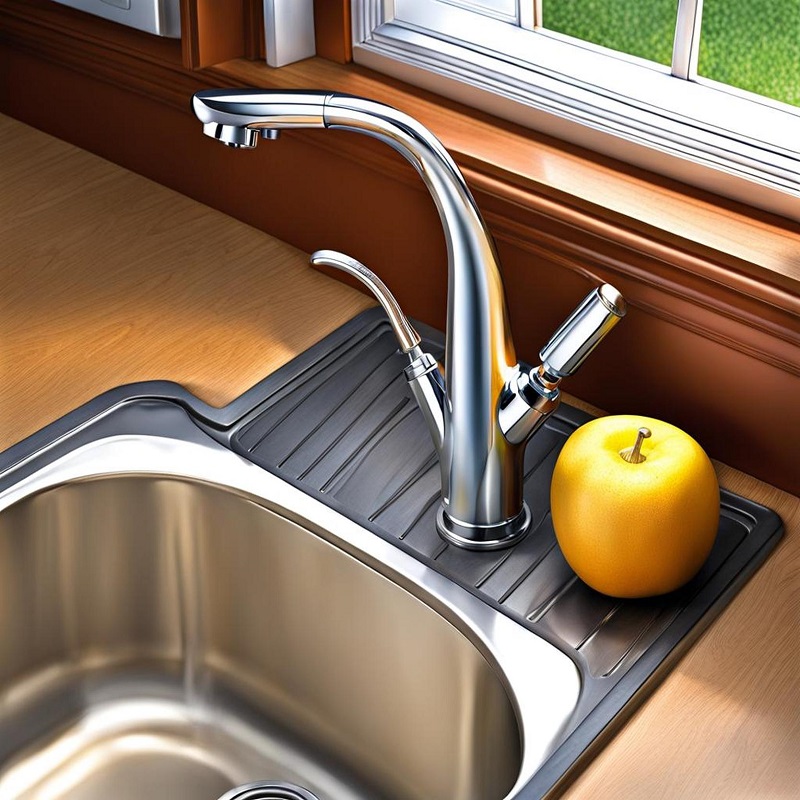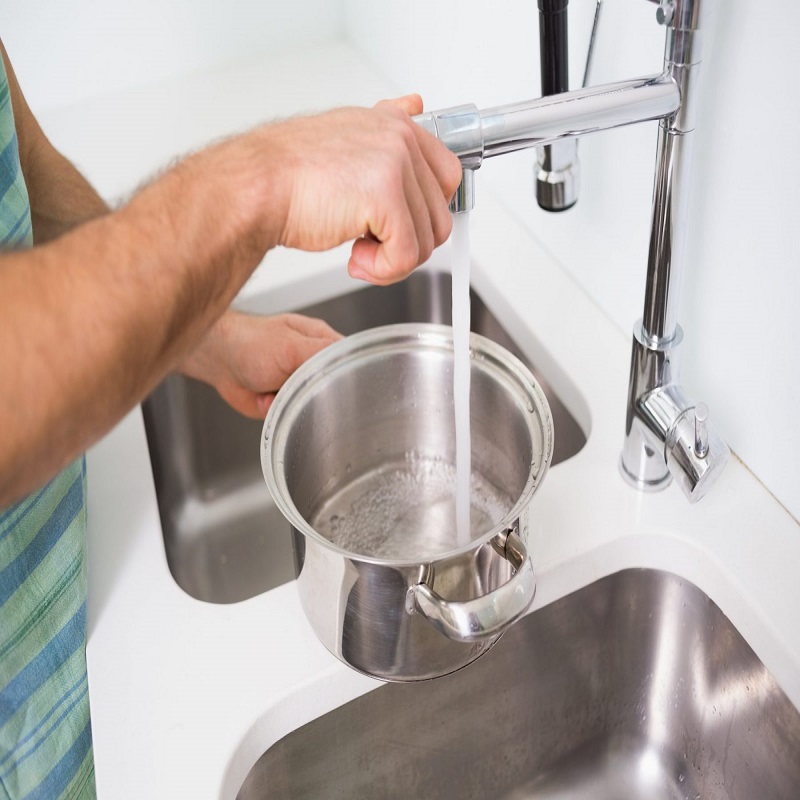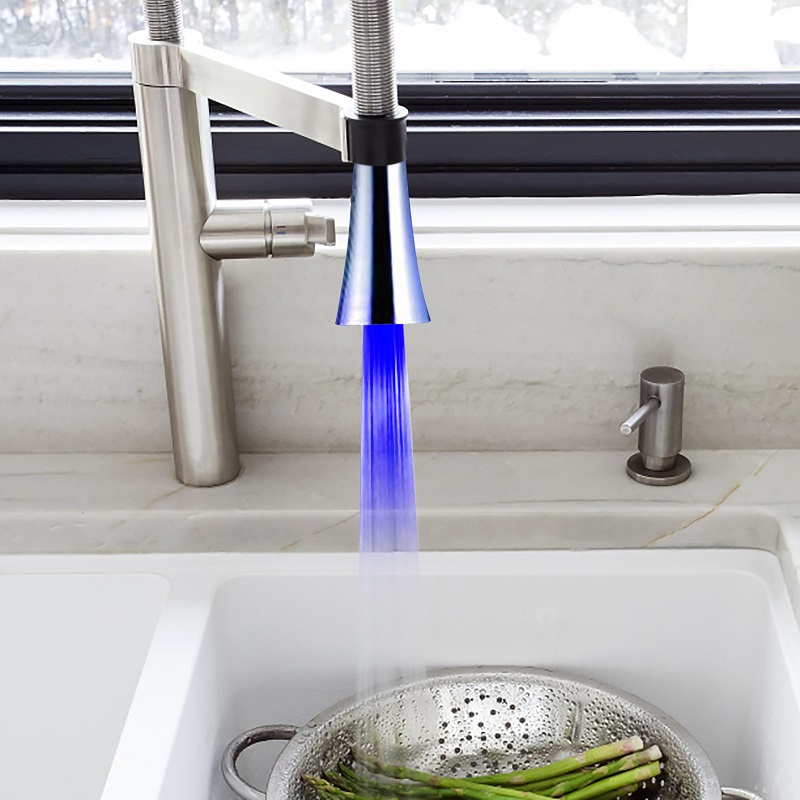Identifying the Cause of Low Water Pressure
Low water pressure in kitchen sink only can be annoying. To fix it, first identify the cause. Common reasons include issues with municipal supply or your home’s plumbing. Let’s examine what to check!

Checking for Widespread Pressure Issues
Start by testing all faucets. If low pressure is everywhere, neighbors may have the same issue. This could signal a municipal supply problem. If they don’t, the issue might be with your home’s water system.
Considering Increased Water Demand and Supply Changes
Have you added more water outlets or appliances? More demand can lower pressure. You might need to upgrade your water main for better flow. Changes in the time of day can also affect water pressure. Keep track of when pressure drops happen to identify patterns.
Inspecting the Pressure Relief Valve Settings
Check your pressure relief valve. It’s bell-shaped and usually on the waterline entering your home. Try adjusting it by turning the screw atop the valve counterclockwise. This might increase the kitchen sink’s water pressure. If the valve is worn out, it could be causing low pressure issues throughout your house.
Troubleshooting Kitchen Sink Specific Issues
After checking for widespread issues and inspecting the pressure relief valve, focus on kitchen sink specifics. Here’s what to do.
Ensuring Proper Valve Operation
First, ensure the valves under the sink are fully open. Two valves control the hot and cold water; both should be turned on completely for full pressure.
Examining Water Supply Hoses for Kinks
Next, inspect the water supply hoses. They should be clear of any kinks that could hinder water flow and cause low pressure.
Cleaning or Replacing the Faucet Aerator
Often, a clogged aerator lowers water pressure. Unscrew it, clean it out, or replace it to improve the flow.
Diagnosing Cartridge Clogs and Solutions
A blocked cartridge can also affect pressure. Remove it, check for debris, and either clean or replace it for better function.

Dealing with Water Heater Related Pressure Drops
If you notice low water pressure from the hot water tap, the problem may involve your water heater. It’s key to ensure that the water heater is functioning correctly as it can directly affect your kitchen sink’s water pressure.
Investigating Hot Water Shut-Off Valves and Pipes
First, check the hot water shut-off valve. This valve controls the flow of hot water to your down kitchen sink. If it’s not fully open or is malfunctioning, your water pressure can drop. See that it’s turned on all the way. If adjusting the valve doesn’t help, you may need to look at the pipes leading to and from the water heater. Any buildup or corrosion can affect water flow and pressure. Inspect for signs of damage or blockages that could be causing the issue. Remember to take caution and ensure safety when inspecting hot water systems. If problems persist after checking these components, it could indicate a more serious issue within the water heater itself. In such cases, it may be best to consult a professional plumber to diagnose and address the problem.
Addressing Water Pressure Problems in Pull-Out Sprayers
Pull-out sprayers in kitchen sinks can add convenience but also suffer from water pressure issues. Here’s how to tackle them.
Cleaning Mineral Build-up in Spray Heads
Mineral deposits can clog spray heads and affect water flow. Follow these steps to clean:
- Detach the spray head from the hose.
- Inspect the nozzle for blockages.
- Soak the spray head in vinegar to dissolve minerals.
- Scrub gently with a brush to remove debris.
- Rinse thoroughly and reattach to the hose.
- Test the water pressure to ensure improvement.
Regular maintenance can prevent build-up and keep water pressure steady. If cleaning doesn’t help, there might be another issue. Check the hose for kinks or replace the spray head if it’s damaged. A consistent water flow is vital for an effective pull-out sprayer.

Exploring Long-Term Fixes
When temporary solutions don’t fix the low water pressure in your kitchen sink, it’s time to consider long-term solutions.
Upgrading to a New Faucet to Improve Water Flow
A new faucet may be the answer to your low water pressure woes. Modern faucets are designed with efficient water flow in mind and can make a significant impact. When shopping for a new faucet, look for one with a high-flow rate. It’s also worth considering models with built-in filtration systems, as they can prevent future clogging from sediments and minerals.
Considering Installation of a Water Booster
If other methods fail, a water booster pump might be needed. This boosts water pressure throughout your home, not just at the kitchen sink. It’s a more involved solution that typically requires professional installation. This could be particularly helpful if you’re in an area with chronic low municipal water pressure. However, before investing, it’s best to consult with a plumber to see if this matches your home’s needs.
If you’ve tried the earlier steps without success or are looking for a more permanent solution, these options can help restore your kitchen sink’s water pressure to an optimal level. Remember to integrate the keywords ‘low water pressure in kitchen sink only’ into your research and decision-making process to ensure you’re finding targeted solutions for your specific issue. Keep in mind that for major changes, contacting a professional is always a safe bet to ensure proper installation and to avoid further issues.
When to Call a Professional Plumber
Dealing with low water pressure in your kitchen sink can be straightforward at times. Simple issues like a closed valve or a clogged aerator can be DIY tasks. However, some problems need expert hands. It’s crucial to know when to call a professional plumber. Doing so can save you time and prevent potential damage.
Identifying Issues Beyond DIY Fixes
Recognize when low water pressure in your kitchen sink only is beyond a DIY fix:
- If there is no clear cause after all basic troubleshooting steps.
- When low pressure persists after replacing the aerator or cartridge.
- If water pressure problems are linked to the main water line.
- When changes in the water system, like new installations, don’t resolve issues.
- If you suspect leaks within walls or under the foundation.
- When adjusting the pressure relief valve doesn’t help.
- If the water heater shows signs of malfunction affecting the hot water pressure.
- When there’s suspect of sediment build-up in old pipes.
Don’t hesitate to consult a plumber when these complex issues arise. Skilled plumbers can assess the situation accurately and provide long-lasting solutions. They have the tools and knowledge required to handle complex plumbing problems safely.

Advantages of kitchen sinks
Practicality and Convenience
One of the most obvious advantages of having a kitchen sink is its practicality and convenience. It provides a dedicated space for washing dishes, pots, and pans, making clean-up after meals a breeze. Without a kitchen sink, we would have to rely on alternative methods, such as using a bathtub or outdoor hose, which can be both time-consuming and inefficient. The kitchen sink also allows for easy access to water, which is essential for cooking, cleaning, and food preparation.
Versatility
Another key advantage of the kitchen sink is its versatility. It can be used for a wide range of tasks, including washing hands, filling pots with water, and rinsing produce. Some kitchen sinks even come with additional features, such as built-in cutting boards or drying racks, further expanding their functionality. This versatility makes the kitchen sink an essential component of any modern kitchen, catering to a variety of needs and preferences.
